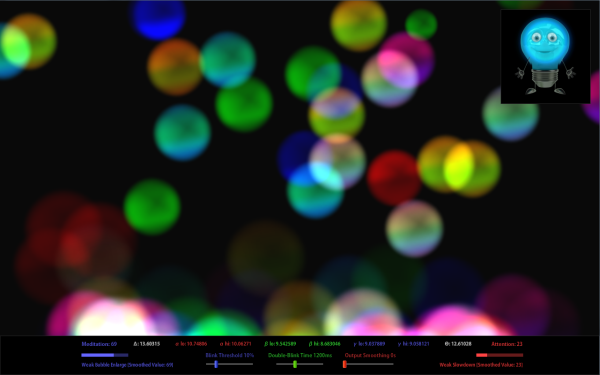
NeuroSky Testing
On the plus side, MindWave is an increasingly cheap EEG headset which is much easier to persuade people to wear and the API is Open enough to hack games and the like (higher resolution raw EEG streams are encrypted and require a tidy fee).
On the negative side eSense doesn’t seem particularly consistent and is not intended or usable for real-time control.
Bubble Flow Test Downloads
Quick Start – Controls
- Tune eye blink detection with the sliders if necessary.
- Use Double Blinks to turn the stream on and off.
- Use Attention eSense to accelerate or slow the bubble stream.
- Use Meditation eSense to grow or shrink the bubbles.
Ensure that blink detection is working well. Close to 100% accuracy is attainable. Don’t squint or exaggerate the blinking action significantly.
The Bulb Indicator will light when signal quality is good, flicker with low signals and dim completely with signal loss. Your blinks should be mirrored by the character consistently.
Other Controls and Visualisation
To add further control dampening use the Smooth Output slider – this weakens the affect of both eSenses on the bubble stream.
The Double Blink Time slider sets the total period during which two blinks are considered a ‘Double Blink’. Usually best set at 750 to 1300 milliseconds.
The other EEG outputs are used arbitrarily to set the colour range and transparency of the bubbles . This is pretty much random in effect, but red maps to alpha, green to beta and blue to gamma. The delta and theta values are combined to influence transparency.
General Results
We’ve tested this unscientifically for a few hours with broadly consistent results using the more basic API of ThinkGear Connector
- Blink Detection works very reliably as a means of real-time control – click rates of 1 per second or slower can be achieved reliably
- Interactive feedback using the blinking bulb character improved immersion and control sensation greatly.
- Using EEG signals to store and release control ‘momentum’ was a more difficult proposition from this brief test – which relies on the preprocessed Attention and Meditation streams from ThinkGear Connector rather than raw EEG output.
- Correct sensor placement for eye blink control was determined by trial and error each time as signal quality readings seemed to have little or no bearing on detection reliability. In respect of the EEG streams there was no way to test or calibrate placement. Poor signal quality was indicated by the flickering bulb so the sensor could be repositioned if necessary.
- By focusing intently on the Attention Indicator or performing calculation, everyone was able to accelerate the stream for a few seconds or more.
- An immediate or controlled reduction of Attention to slow the stream couldn’t be achieved consistently by any of us.
- The excitement caused at the stream slowing (coincidentally or not) when we were trying for this led to a spike in eSense; hence the additional dampening was added.
- Controlling the bubble size with Meditation eSense proved similarly problematic; easy to max out, but hard to maintain the highest level or reduce to low levels in a controlled manner.
- Physical relaxation, eye closing or focus on breathing usually increased Meditation eSense significantly for several seconds within a few seconds. Maintenance of high levels through these ‘physical’ strategies was rarely achieved beyond 30 seconds.
- Testers enthusiastically over-estimated their control consistency; perhaps as the illusion/sensation of control was so powerful when action matched expectation.
Light Box Support
Cause and Effect Sensory Light Box is a touch skills app on iPad and Android, the Windows and OSX versions are free downloads. Support for blink switch control is now included and NeuroSky eSense levels can also be displayed when using the other control methods.
Blink Game Example
Switch Box Invaders was written for iOS4 and a switch user with complex needs; prior to Apple adding nifty switch accessibility in iOS7 there weren’t really any playable games for him. It was designed to account for developing and erratic switch skills so a good candidate for experimenting with blink control.
Downloads for Windows and OSX desktops are available. The game is played using a single switch press which toggles the direction of the UFO and fires a bullet, provided the previous bullet has left the screen or hit something.
Double-blinks are used to start the game – timing requires single blinks are used to control the UFO during gameplay.
Accumulative eSense values are also employed, with high Attention preemptively detonating the enemy bombs and high Meditation values repairing the UFO if it is damaged.
Feedback appreciated if you find these of use, or can achieve better control than us.